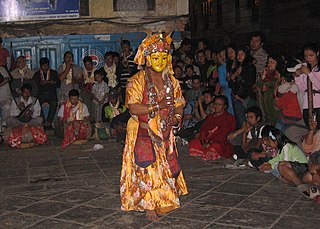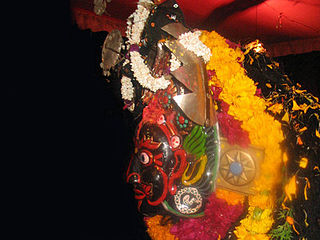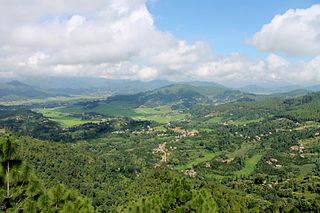
Bhaktapur, also known as Khwopa, is a city in the east corner of the Kathmandu Valley in Nepal about 13 kilometres (8.1 mi) from the capital city, Kathmandu. It is located in and serves as the headquarters of Bhaktapur District in Bagmati Province of Nepal. It is administratively divided into 10 wards.

The culture of Nepal encompasses the various cultures belonging to the 125 distinct ethnic groups present in Nepal. The culture of Nepal is expressed through music and dance; art and craft; folklore; languages and literature; philosophy and religion; festivals and celebration; foods and drinks.

Banepa, a municipality and historical town is a valley situated at about 1,500 m (4,900 ft) above sea level in central Nepal which is at about 25 kilometres (16 mi) east from Kathmandu. At the time of the 2011 Nepal census, it has a population of 55,528. The main attraction of Banepa is the temple of Chandeshwori, located approximately 1 km (0.62 mi) northeast of the town along the Rudramati River. The Dhaneshwor Temple is 1 km south of the town. Banepa is also known for its eight different temples of Lord Ganesh, Narayanthan, Bhimshenthan and eight different ponds.

The Sunuwar is an indigenous tribe from Nepal and some areas of India. They speak the Sunuwar language. According to the 2001 census of Nepal, 17% of the tribe follow the Kirant religion and adopt the Mundhum (Kiranti) culture.

Kapilvastu district, often Kapilbastu, is one of the districts of Lumbini Province, Nepal. The district, with Kapilbastu municipality as its district headquarters, covers an area of 1,738 square kilometres (671 sq mi) and in 2001 had a population of 481,976, which increased to 571,936 in 2011. Kapilvastu district has 3 number of seats for central whereas 6 seats for state level elections.

Kathmandu District is a district located in Kathmandu Valley, Bagmati Province of Nepal. It is one of the 77 districts of Nepal, covers an area of 413.69 km2 (159.73 sq mi), and is the most densely populated district of Nepal with 1,081,845 inhabitants in 2001 and 1,744,240 in 2011. The district's headquarter is Kathmandu Metropolitan City, also the capital of Nepal. It is also a famous tourist spot as there are many religious temples, attracting places.

Newar Dance consists of the whole array of dances that are traditionally performed by Newars.

Bhairab Naach is an ancient masked dance performed by Newar community in the Kathmandu Valley of Nepal as part of the Indra Jatra festival and named after Bhairab.

Madhyapur Thimi, also known as Thimi, is a municipality in Bhaktapur District in the Bagmati Zone of central Nepal. Thimi lies between Kathmandu, Lalitpur and Bhaktapur in the Kathmandu Valley. It is one of the ancient cultural and historical places along the trade route from Bhaktapur to Kathmandu. The city is situated on elevated land and occupies an area of 11.47 square kilometres (4.43 sq mi), divided into nine administrative wards.

Nagadesh is an ancient Newar city in Madhyapur Thimi Municipality in Bhaktapur District in the Bagmati Zone of central Nepal. In 2011 it had a population of approximately 6,900 with more than 1500 houses in it, according to the 2011 Nepal census. At the time of the 1991 Nepal census it had a population of 4,237 with 693 houses in it. Most people are engaged in farming.

Tokha Chandeshwari is a village and former Village Development Committee that is now part of Tokha Municipality in Kathmandu District in Province No. 3 of central Nepal. At the time of the 2011 Nepal census it had a population of 3961. Tokha Chandeshwari now is part of Tokha municipality.

Sankhu (साखु) is the ancient Newar town located in the north-eastern corner of Kathmandu Valley which is about 17 km from the city center of Kathmandu. Sankhu was formerly divided into three Village Development Committee, namely, Pukhulachhi, Suntol and Bajrayogini. Recently the town of Sankhu has been declared as Shankharapur Municipality merging three above-mentioned VDCs and other neighbouring VDCs. At the time of the 2011 Nepal census it had a population of 4333 living in 928 individual households. Sankhu lies between river Salinakhu in east and Asakhu in the west.

Sunakothi is a small town located about 4 km (2.5 mi) south of the main Lalitpur city in Lalitpur District. According to 2011 Nepal census, Sunakothi has a population of 10,092 living in 2397 individual households. Most of the people living in Sunakothi are Newar. The offshoot road near the Satdobato segment of the Ring Road leads to Sunakothi. This road ultimately leads to Lele and is referred to as Laxmi Prasad Devkota Marga .Thecho is situated on the southern part of Sunakothi, Bungamati and Bhaisipati on west, Dhapakhel on east and Khumaltar and Nakhipot on North.

Badegaon is a village in the Godawari Municipality of the Lalitpur District of Nepal. Badegaon is situated in the foothills of Phulchowki and is about 5 km south of Patan. It has five wards. Buddha Madhyamik Vidyalaya is in ward no. 3. It has one health post with 24 hours emergency services. Ex-Prime Minister & Nepali congress Leader Krishna Prasad Bhattarai has recently settled down in one of the jungles in Badegaon.

Indra Jātrā, most commonly known as Yenyā is the biggest religious street festival in Kathmandu, Nepal. Ye means "Kathmandu" and Ya means "celebration", together it means "celebration inside Kathmandu" in Nepal Bhasa. The celebrations consist of two events, Indra Jātrā and Kumāri Jātrā. Indra Jātrā is marked by masked dances of deities and demons, displays of sacred images and tableaus in honor of the deity Indra, the king of heaven. Kumāri Jātrā is the chariot procession of the living goddess Kumari.
Here is a list of glossary of Culture of India in alphabetical order:

Bangomunda a tehsil located at about 95 km from Balangir in Titlagarh sub-division of Bolangir district, Odisha, India, has historical importance. Bangomunda is the new name of Banganmura which means Brinjal Firm.

Siddhikali Temple is a Hindu temple located in Thimi, Nepal. The two storeys roofed temple is dedicated to Lord Kali, Shiva and Ganesh. It is also believed that this Shaktipeeth is formed due to the falling of right eye of the corpse of Sati. This place is located in Inayekwo, in the north west of Thimi. The temple is also known as Inayekwo Dyo in Nepal Bhasa language. And Siddhikali Temple is also known as Chamunda, one of the goddess of Astamatrika. The majestically impressive Siddhikali temple has numbers of Pataa streaming down the front. There's a Satah (rest-house) opposite to temple and multiple Falcha (Inns) and several smaller shrines to the rear and nearby and several stone taps around the place. The artwork around the Siddhikali temple is fantastic and worth a close inspection.

















